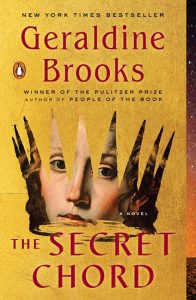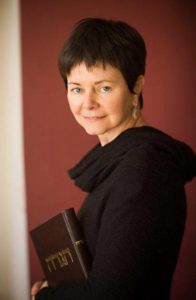The Secret Chord: A New Look at an Old Book
 The Secret Chord by Geraldine Brooks has everything — love, hate, jealousy, violence, intrigue, battles, and faith. And why shouldn’t it? It’s a retelling of the biblical story of David, though the word “retelling” doesn’t do justice to Brooks’s success in breathing new life into the three-thousand-year-old character many readers think they already know.
The Secret Chord by Geraldine Brooks has everything — love, hate, jealousy, violence, intrigue, battles, and faith. And why shouldn’t it? It’s a retelling of the biblical story of David, though the word “retelling” doesn’t do justice to Brooks’s success in breathing new life into the three-thousand-year-old character many readers think they already know.
David is familiar to us as the man who killed the giant Goliath, united the people of Israel, played the harp, and wrote many of the Psalms. That’s about all I remembered of him when I opened the book. The novel so intrigued me that I’ve since reread the biblical accounts to see how they differ from Brooks’s.
David “is the first man in literature whose story is told in detail from early childhood to extreme old age,” Brooks writes in the afterword. But the biblical story is abbreviated and conveyed in fits and starts — in Samuel I and II, Kings I, and Chronicles. It’s populated with people whose actions we see but whose feelings or motivations are often unsaid.
Brooks fills in the gaps. The David she shows us is a fully realized man, heroic and flawed, sensitive and cruel, a warrior and a musician, a romantic lover and a heartless destroyer. We hear from some of his siblings (he had seven), his wives (he had eight), and his children (he had nine).
It’s the women in The Secret Chord who most interested me. We read about them in the Bible, but there we know them only from the men’s perspectives. Consider the biblical Bathsheba, David’s eighth wife [2 Samuel 11:2]:
“One evening David got up from his bed and walked around on the roof of the palace. From the roof he saw a woman bathing. The woman was very beautiful, and David sent someone to find out about her. The man said, ‘Is not this Bathsheba, the daughter of Eliam and the wife of Uriah the Hittite?’ And David sent messengers, and took her; and she came in unto him, and he lay with her; for she was purified from her uncleanness; and she returned unto her house. And the woman conceived; and she sent and told David, and said: ‘I am with child.’”
 The traditional view has been that Bathsheba tempted David, but Brooks shows us Bathsheba’s point of view so deftly that I wondered how I’d missed it before. Speaking to the prophet Natan, who narrates the story, Bathsheba describes her fear of David: “Do you think I did not fear, dragged from my home in the dark, to be debauched and discarded?”
The traditional view has been that Bathsheba tempted David, but Brooks shows us Bathsheba’s point of view so deftly that I wondered how I’d missed it before. Speaking to the prophet Natan, who narrates the story, Bathsheba describes her fear of David: “Do you think I did not fear, dragged from my home in the dark, to be debauched and discarded?”
She had gone to the roof the night of the attack to have privacy for her ritual bath. With Uriah away fighting for David, she didn’t want to bathe at home, where his many male servants could spy on her. She couldn’t have known that David would have a restless night, walk out to his roof, see her, and cruelly succumb to temptation.
Mikhal, David’s first wife, also suffered at his hands. Mikhal, the daughter of King Shaul, loved David, both the Bible and Geraldine Brooks tell us. But when David flees Shaul’s court, he deserts her. Shaul forces Mikhal to marry another man, Palti, and in time, they grow to love each other.
After Shaul’s death, David demands that she return to him. The Bible dispenses with Palti and Mikhal’s parting in just a few sentences [2 Samuel 3]:
“And David sent messengers to Ish-bosheth, Saul’s son, saying: ‘Deliver me my wife Michal, whom I betrothed to me for a hundred foreskins of the Philistines.’ And Ish-bosheth sent, and took her from her husband, even from Paltiel the son of Laish. And her husband went with her, weeping as he went, and followed her to Bahurim. Then said Abner unto him: ‘Go, return’; and he returned.”
In The Secret Chord, we feel their desperation and their longing for each other. We see Palti staggering as he walks behind Mikhal, who’s being carried in a litter. The heat is beating down on him, and “his tunic soaked through with his own sweat, his face as purple as a grape.” He cries out, and the young soldiers mimic him. Palti heads back to home only when Mikhal leaves the litter to urge him to return to their children and promises him that she’ll find a way to return to him.
Brooks chooses as the first person narrator, the prophet Natan, who in the Bible fearlessly tells the king the truth. (She uses transliterated Hebrew for characters’ names rather than the more familiar English spellings to give readers a sense of distance.)
Natan is a plausible narrator. Chronicles in the Bible says the king’s story is told in the history of Natan the prophet, but that book, if it ever existed, is no longer around. The Secret Chord is a fine substitute for the missing book. In it, Natan says:
“Because of me, he will live in death as he did in life, a man who dwells in the searing glance of the divine, but has sweated and stank, rutted without restraint, butchered the innocent, betrayed those most loyal to him, who loved hugely and was kind, who listened to brutal truth and honored the truth-teller, who flayed himself for his wrongdoing, who built a nation, made music that pleased heaven and left psalms in our mouths that will be spoken by people yet unborn.”
Natan tells it all in unstinting detail.
Whether you can recite the Bible chapter and verse or not at all, Brooks’s imaginative writing is bound to sweep you up into the second Iron Age and David’s turbulent life.
Janet Willen
Janet Willen is author of Speak a Word for Freedom: Women against Slavery (2015) and Five Thousand Years of Slavery (2011), written with Marjorie Gann and published by Tundra Books. Publishers Weekly called Speak a Word for Freedom an “engrossing study of female abolitionists from the 18th century to the present day” and gave the book a starred review. Five Thousand Years of Slavery was named a 2012 Notable Book for a Global Society by the International Reading Association and a Silver Winner in young adult nonfiction of ForeWord Reviews, and it received a starred review from School Library Journal. A writer and editor for more than thirty years, Janet has written many magazine articles and has edited books for elementary school children as well as academic texts and a remedial writing curriculum for postsecondary students. Janet lives in Silver Spring, Maryland.